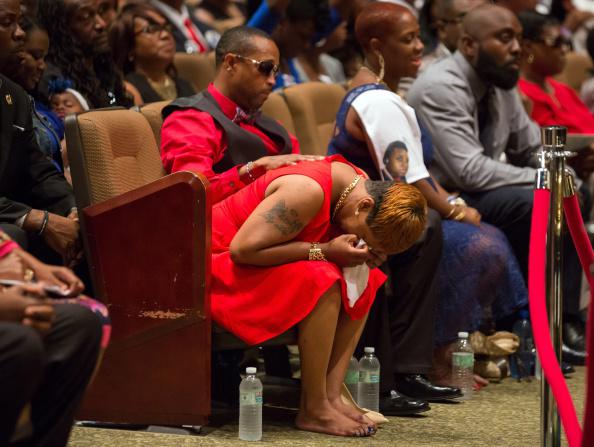The New York Times published a profile of Ferguson shooting victim Michael Brown on Sunday, and the piece has itself become a source of controversy. The article, “Michael Brown Spent Last Weeks Grappling With Problems and Promise,” has been heavily criticized by both activists and journalists, with specific attention being paid to its fifth paragraph:
Michael Brown, 18, due to be buried on Monday, was no angel, with public records and interviews with friends and family revealing both problems and promise in his young life. Shortly before his encounter with Officer Wilson, the police say he was caught on a security camera stealing a box of cigars, pushing the clerk of a convenience store into a display case. He lived in a community that had rough patches, and he dabbled in drugs and alcohol. He had taken to rapping in recent months, producing lyrics that were by turns contemplative and vulgar. He got into at least one scuffle with a neighbor.
It’s not hard to see why this might be upsetting. There are people who believe that Michael Brown was a dangerous “thug” whose aggressive behavior toward Ferguson police officer Darren Wilson justified Wilson’s use of deadly force. But Brown had no adult criminal record (though he is suspected in the convenience store robbery that occurred shortly before his death) and no known juvenile record. A widespread rumor that Brown broke Wilson’s eye socket has already been debunked, while reactionary assertions that Brown was a gang member are based on evidence that would be laughable were the circumstances of this case not so serious. Even if these far-fetched characterizations and allegations were true, though, the fact remains that Brown was not armed—and was standing 35 feet away from Darren Wilson’s police car—when he fell dead after adopting what witnesses have described as a posture of surrender. Wilson’s actions, based on the available evidence, were at best questionable and at worst homicidal. So it is understandable that activists and analysts would be concerned that the Times, the “paper of record,” was endorsing the fringe idea that Brown should be held responsible for his own death.
But that’s not what happened. The Times’ piece is not about the incident in which Brown was shot. It doesn’t explicitly or implicitly suggest that Wilson may have been justified in killing him, and it definitely doesn’t insinuate that Brown was “destined for a life of criminality and destitution,” as Mic.com’s Jared Keller writes.
The Times piece, rather, is a profile of Brown’s life that, on balance, is positive about the direction he was heading. It puts several statements on the record that contradict the idea that he was a violent or disturbed person. The comments in the piece that are most critical of Brown’s character are made by his own parents.
To wit, the Times article characterizes Brown as:
— Someone who “spoke seriously about religion and the Bible” and had recently experienced a renewal of faith. (This is the lede of the piece.)
— Someone who was “pointed toward a trade college and a career.”
— Someone who was “joking and outgoing with those close to him.”
— Someone who, according to a school official, had worked assiduously to recover from a stretch of poor academic performance—taking a credit recovery class and becoming “the most serious in that class” about his work.
— Someone who, according to a friend, “never threw a real punch.”
— Someone who, though he may have come off as edgy on rap tracks, did so because he had “adopted a persona,” and who also praised his stepmother in one such song.
It’s true that the piece suggests Brown struggled with his grades, could “talk back” to his parents, and may have known some gang members. Those suggestions, though, are made by his father and mother—and if you accept that the Times has the right to profile Brown in the first place, there’s no reason why they aren’t entitled to mention unflattering information about him that they’re given by their sources, especially if those sources are parents and friends who obviously don’t have an ax to grind.
Where the Times erred most clearly was in calling Brown “no angel.” Out of context of the piece—and in the context of the online smear campaign against Brown—the phrase is indeed alarming. The opposite of an angel is a devil, and the implication could be that “bad people” get what they deserve. Perhaps, but read in sequence with the rest of the story, it seems clear that the “angel” image is meant to play into a quote, attributed to Brown by his father, about seeing an angel and devil in storm clouds and taking them as a sign. (A Times editor said as much today.) “No angel” is a loaded term, and the Times might have thought better than to use it in this context, but it is not indicative of the tone of their profile as a whole. Taken in its entirety, the Times’ article about Michael Brown tells the story of his life fairly, in the words of the people who knew him best.
Update, Aug. 25, 4:25 p.m.: The writer of the Times piece, John Eligon, addressed some of the criticism his article has received in an interview with Times public editor Margaret Sullivan.
